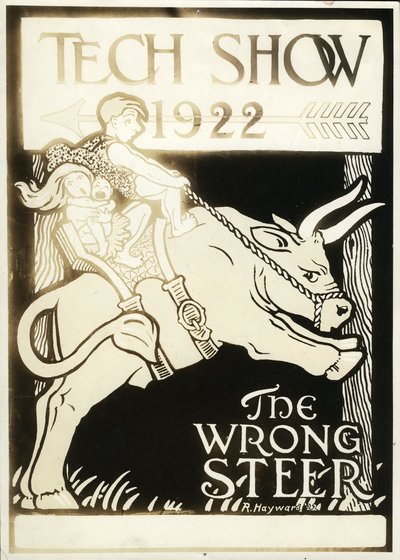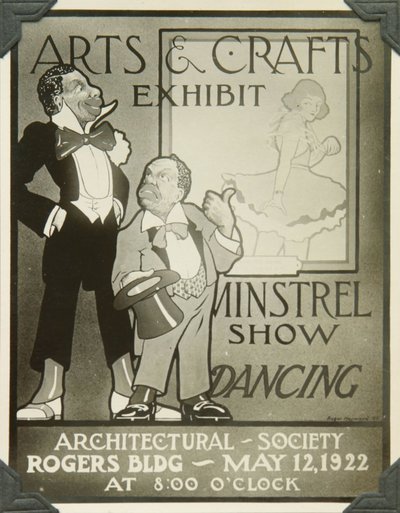After resuming his studies in 1921, Roger was elected to the job of Art Editor for Technique, the school annual. He also illustrated various posters for the architectural society and other school functions, including a Valentine’s Day dance, Arts and Crafts Exhibit, and the First Architectural Society Smoker. Roger undertook various complex architectural drawings for his studies, but continued to embrace other forms of artistic expression, including a sculpture that was unveiled at a 1922 arts and crafts exhibition. One of Roger’s designs was chosen for the 1922 annual MIT Tech Show poster, and he also won first prize for the design of a poster that was submitted to the Junior Dramatic League of Chicago.
Before leaving MIT, a souvenir booklet was made by one of Hayward’s fellow architecture students, in which each student was to contribute a page containing sketches about themselves. Under the caption “the way I would like to be remembered,” Roger sketched himself surrounded by four or five canvasses on easels which he was furiously attacking with paint and brush all at once. Meanwhile, Roger’s future wife, Betty Hatfield, originally from a farm in Green County, Iowa, was finishing up her first year as a graduate student of English at Radcliffe College during Roger’s senior year at MIT. Following a brief courtship, Roger and Betty Hayward were married on September 10, 1922.
Before the sanctioned start of his colorful lifelong union with Betty began, Roger was recommended by MIT faculty for the degree of Bachelor of Science. Upon graduation Roger received a great number of honors, including a prize from the Boston Society of Architects and two bronze F. W. Chandler medals from MIT, prizes that came with various sums of cash. For earning the highest general academic standing over four years, the school awarded Roger the Rotch Prize, an honor that was accompanied by $200. He was also recognized by the American Institute of Architects for general excellence in architecture with a gold and silver Institute medal, the first student from MIT to do so. But even though Roger was well recognized for outstanding achievement for his graded accomplishments as a student, later in life he would remark that:
“The most important thing I learned in school was how to learn for myself.”


